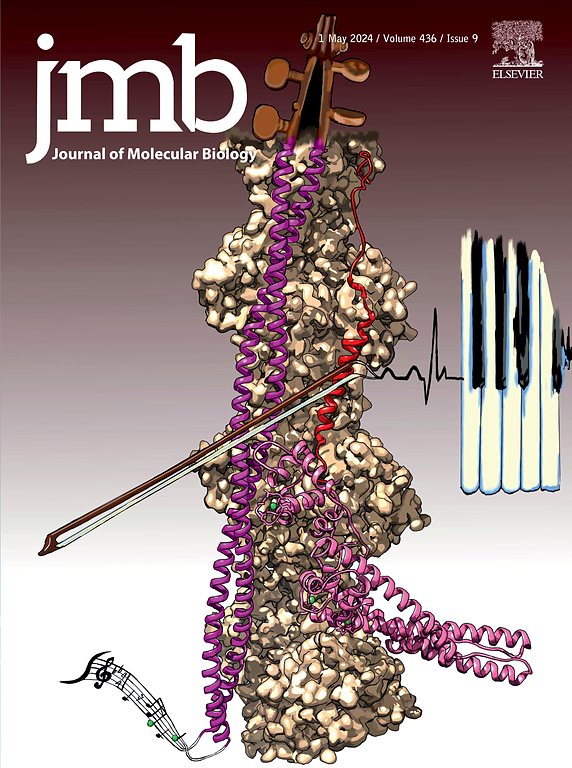Off-pathway oligomers of α-synuclein and Aβ inhibit secondary nucleation of α-synuclein amyloid fibrils
IF 4.7
2区 生物学
Q1 BIOCHEMISTRY & MOLECULAR BIOLOGY
引用次数: 0
Abstract
-Synuclein (Syn) is a key culprit in the pathogenesis of synucleinopathies such as Parkinson’s Disease (PD), in which it forms not only insoluble aggregates called amyloid fibrils but also smaller, likely more detrimental species termed oligomers. This property is shared with other amyloidogenic proteins such as the Alzheimer’s Disease-associated amyloid- (A). We previously found an intriguing interplay between off-pathway A oligomers and A fibrils, in which the oligomers interfere with fibril formation via inhibition of secondary nucleation by blocking secondary nucleation sites on the fibril surface. Here, using ThT aggregation kinetics and atomic force microscopy (AFM), we tested if the same interplay applies to Syn fibrils. Both homotypic (i.e. Syn) and heterotypic (i.e. A) off-pathway oligomers inhibited Syn aggregation in kinetic assays of secondary nucleation. Initially soluble, kinetically trapped A oligomers co-precipitated with Syn(1–108) fibrils. The resulting co-assemblies were imaged as clusters of curvilinear oligomers by AFM. The results indicate that off-pathway oligomers have a general tendency to bind amyloid fibril surfaces, also in the absence of sequence homology between fibril and oligomer. The interplay between off-pathway oligomers and amyloid fibrils adds another level of complexity to the homo- and hetero-assembly processes of amyloidogenic proteins.

α-突触核蛋白和Aβ的通路低聚物抑制α-突触核蛋白淀粉样原纤维的二次成核。
α-突触核蛋白(αSyn)是突触核蛋白病(如帕金森病)发病机制的关键罪魁祸首,在帕金森病中,α-突触核蛋白不仅形成称为淀粉样原纤维的不溶性聚集体,还形成更小的,可能更有害的称为寡聚物的物质。这一特性与其他淀粉样蛋白(如阿尔茨海默病相关淀粉样蛋白-β (Aβ))相同。我们之前发现了通路外的Aβ低聚物和Aβ原纤维之间有趣的相互作用,其中低聚物通过阻断原纤维表面的二次成核位点抑制二次成核来干扰原纤维的形成。在这里,使用ThT聚集动力学和原子力显微镜(AFM),我们测试了相同的相互作用是否适用于αSyn原纤维。在二次成核的动力学分析中,同型(即αSyn)和异型(即Aβ)通路外寡聚物均抑制αSyn聚集。最初可溶,动力学捕获的Aβ低聚物与αSyn(1-108)原纤维共沉淀。所得的共组装体通过AFM成像为曲线低聚物簇。结果表明,在淀粉样蛋白原纤维和低聚物之间没有序列同源性的情况下,非通路低聚物一般倾向于结合淀粉样蛋白原纤维表面。通路外低聚物和淀粉样原纤维之间的相互作用为淀粉样蛋白的同源和异源组装过程增加了另一层次的复杂性。
本文章由计算机程序翻译,如有差异,请以英文原文为准。
求助全文
约1分钟内获得全文
求助全文
来源期刊

Journal of Molecular Biology
生物-生化与分子生物学
CiteScore
11.30
自引率
1.80%
发文量
412
审稿时长
28 days
期刊介绍:
Journal of Molecular Biology (JMB) provides high quality, comprehensive and broad coverage in all areas of molecular biology. The journal publishes original scientific research papers that provide mechanistic and functional insights and report a significant advance to the field. The journal encourages the submission of multidisciplinary studies that use complementary experimental and computational approaches to address challenging biological questions.
Research areas include but are not limited to: Biomolecular interactions, signaling networks, systems biology; Cell cycle, cell growth, cell differentiation; Cell death, autophagy; Cell signaling and regulation; Chemical biology; Computational biology, in combination with experimental studies; DNA replication, repair, and recombination; Development, regenerative biology, mechanistic and functional studies of stem cells; Epigenetics, chromatin structure and function; Gene expression; Membrane processes, cell surface proteins and cell-cell interactions; Methodological advances, both experimental and theoretical, including databases; Microbiology, virology, and interactions with the host or environment; Microbiota mechanistic and functional studies; Nuclear organization; Post-translational modifications, proteomics; Processing and function of biologically important macromolecules and complexes; Molecular basis of disease; RNA processing, structure and functions of non-coding RNAs, transcription; Sorting, spatiotemporal organization, trafficking; Structural biology; Synthetic biology; Translation, protein folding, chaperones, protein degradation and quality control.
 求助内容:
求助内容: 应助结果提醒方式:
应助结果提醒方式:


